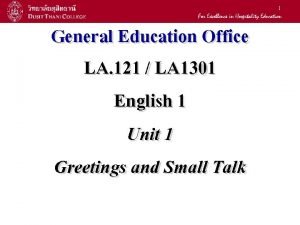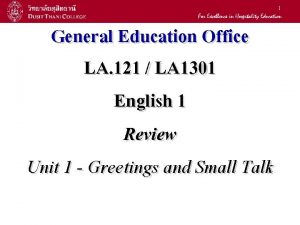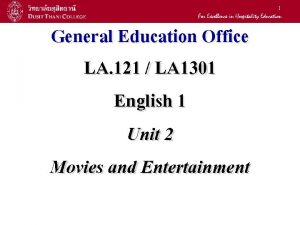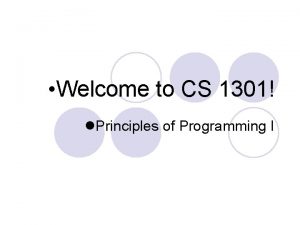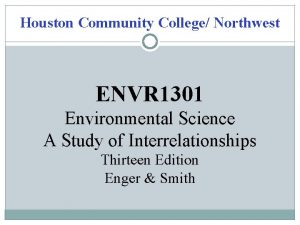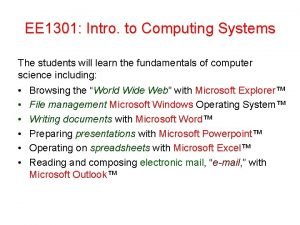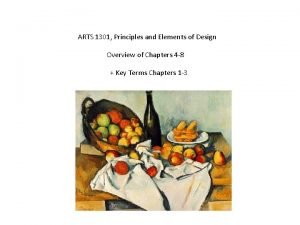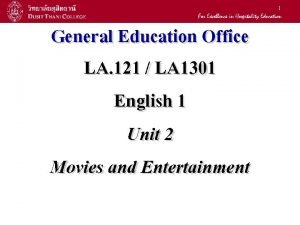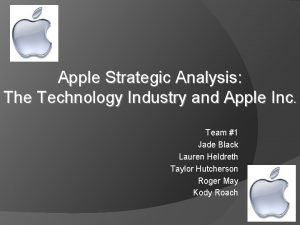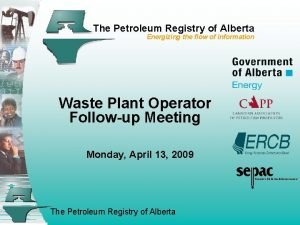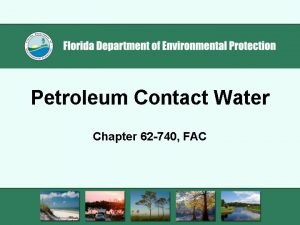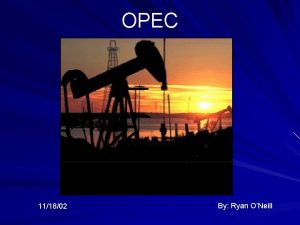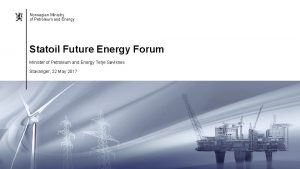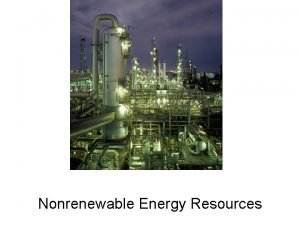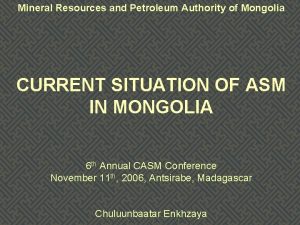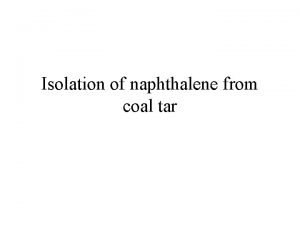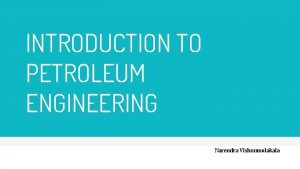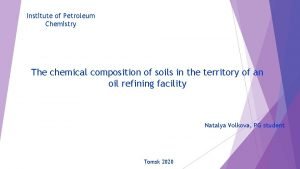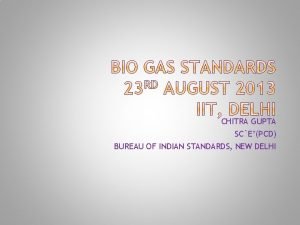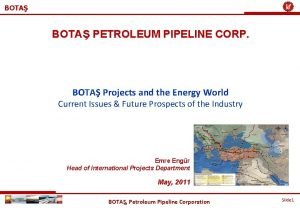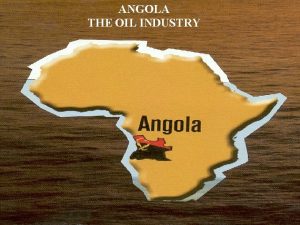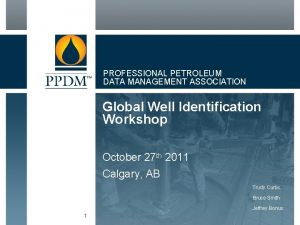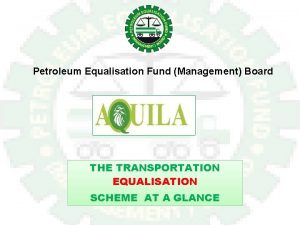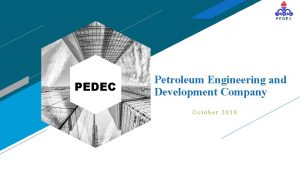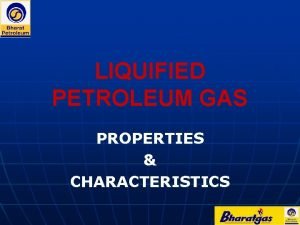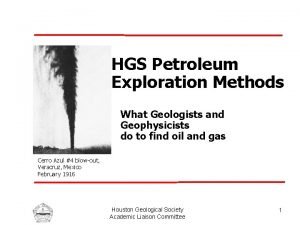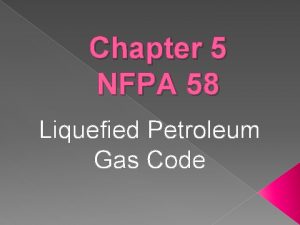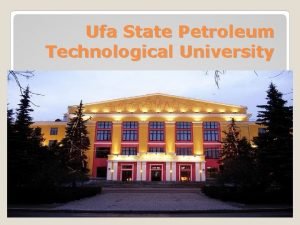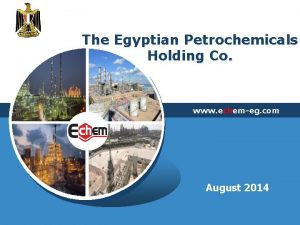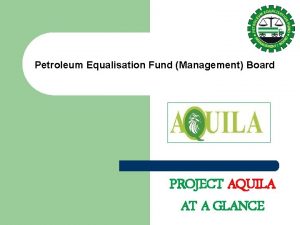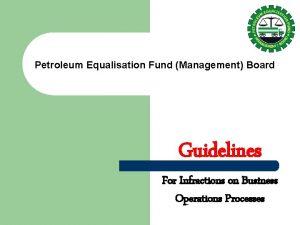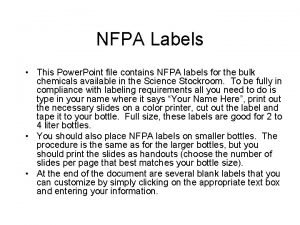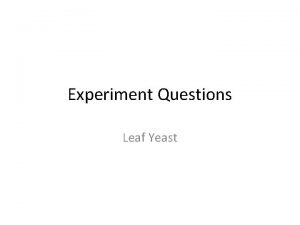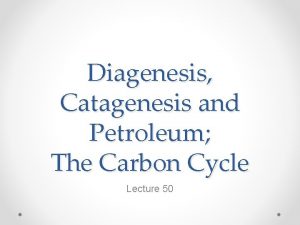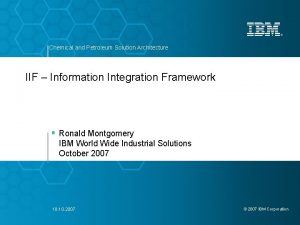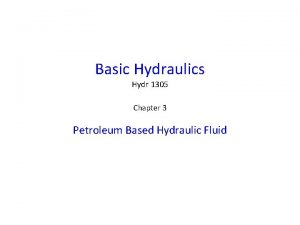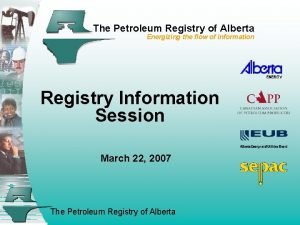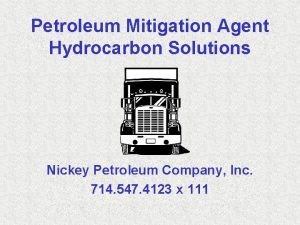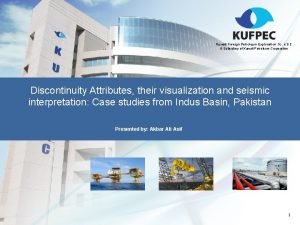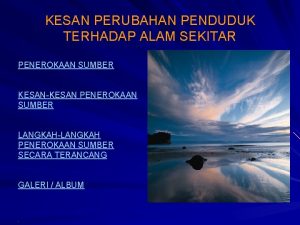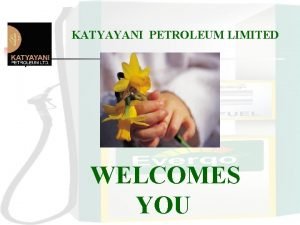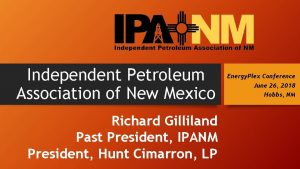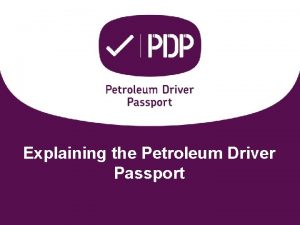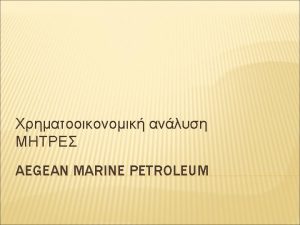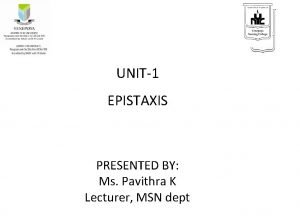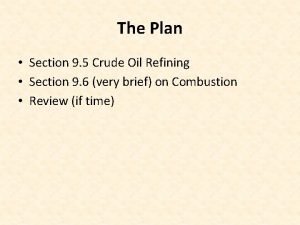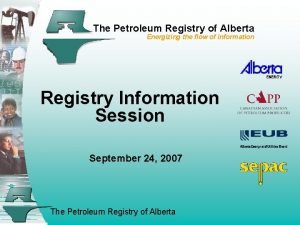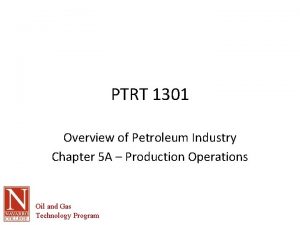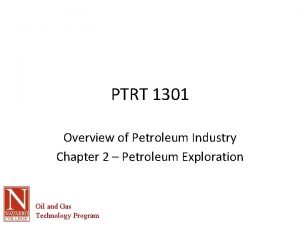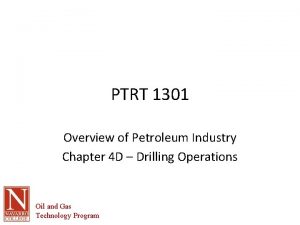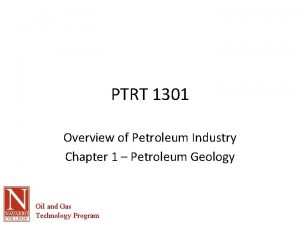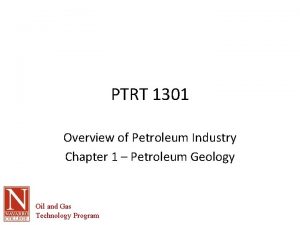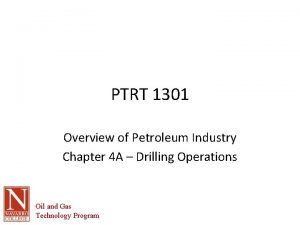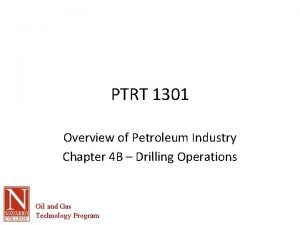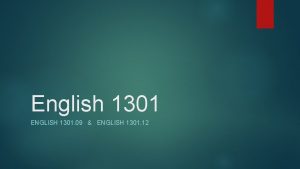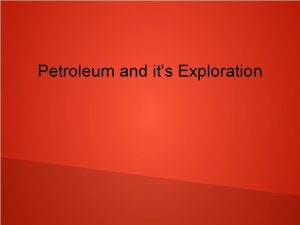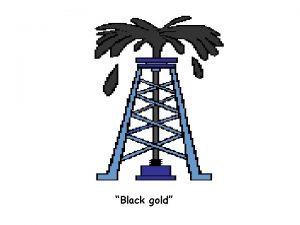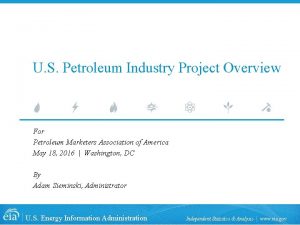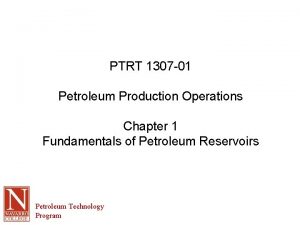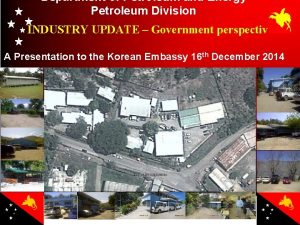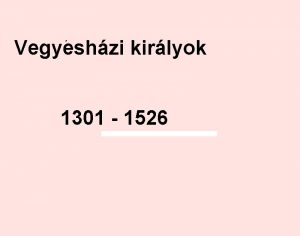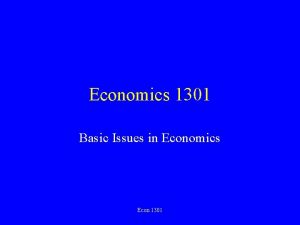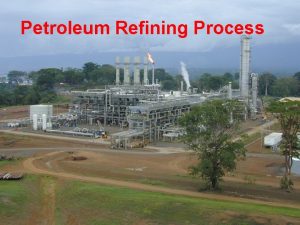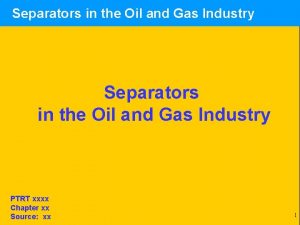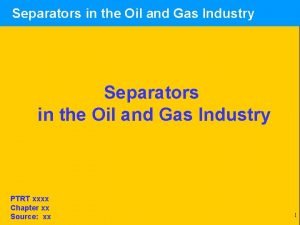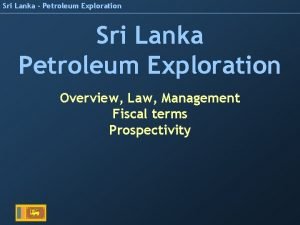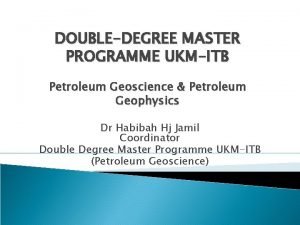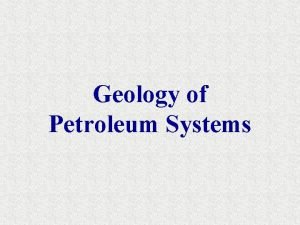PTRT 1301 Overview of Petroleum Industry Chapter 5




















































- Slides: 52

PTRT 1301 Overview of Petroleum Industry Chapter 5 B – Production Operations Oil and Gas Technology Program

Surface Handling of Well Fluids • Properties of fluids – High velocity, – Turbulent – expanding mixture • • • hydrocarbon liquids Gases Water Solids Other contaminants – Fig. 5. 35 shows steps needed to separate salable fractions • Separation – Horizontal – Vertical – Staged Oil and Gas Technology Program

Oil and Gas Technology Program

Removing Free Water • Readily separates water from oil by gravity • Free-water knock out – Vertical or horizontal (three-phase shown) Oil and Gas Technology Program

Separating Gases from Liquids • Centripetal acceleration used to “break out” gases from liquids • Horizontal or vertical configuration • Multiple tubes can be used • Multiple stages can also be used Oil and Gas Technology Program

Multi-stage Separation Oil and Gas Technology Program

Paraffin and Emulsions • Paraffin – Steam treating used to remove – Best treated down hole (well treatment) • Emulsions - formed by 2 liquids that will not normally mix together – 2 liquids are trapped inside the other in microscopic (usually globules or droplets of one inside the other) - See fig. 5. 39 – Water-in-oil = butter – Oil-in-water = milk • Typically formed by agitation – Highly subdivided components – Separation prevented by surface tension – asphalt, resins, organic acids • Must break the emulsions to complete the separation process – Tight—hard to break – Loose—easy to break • Techniques for “breaking” emulsions – Chemical – Heat treatment – electricity Oil and Gas Technology Program

How Emulsions are Broken • Chemical additives – Cause droplets to coalesce – Reduces surface tension – Large droplets will settle out • Heat treatment – Moving the droplets around faster cause droplets to coalesce – Often an auxiliary process to speed up separation – Use as little heat as possible to prevent valuable lighter hydrocarbons from boiling off • Electricity – Changes the electrical charge on “polar” molecules (+ and – ends of molecule) Oil and Gas Technology Program

Chemical Treatment Oil and Gas Technology Program

Types of Emulsion Treaters • Holding tank to allow water to settle out • Line heater added to tank called flow line treater • Combinations in a single unit – Oil/gas separator – FWKO heater – Filter • Can operate at atmospheric pressure but often operate at low pressure (liquids boils at lower temperature) • Either vertical or horizontal • Treatment chemicals added just upstream of the unit using a “metering pump” Oil and Gas Technology Program

Heater Treater • Vertical (Fig. 5. 42) • Heat applied using fire tube • Emulsion & output oil passes through heat exchanger to reduce oil temp and avoid loss of light ends. This also preheats the incoming emulsion. • Pan – helps break out trapped gas – Drains to the bottom through downcomer – Heat & chemicals break the emulsion allowing oil to float upwards • Combination of heater, separator and free-water knock out • Horizontal (Fig 5. 43) – – Larger treating section Larger volume of fluid Needs more space Limited sediment handling. Oil and Gas Technology Program

Oil and Gas Technology Program

Field Handling of Natural Gas • Several Key Steps required to remove impurities – water – Solids – Toxic and corrosive chemicals • Control pressure for delivery to downstream facilities – Regulator to reduce pressure – Compressor to increase pressure • Further processing to prepare the gas for sale Oil and Gas Technology Program

Preventing Hydrate Formation • Pressure drop during gas extraction, processing, or transport • Causes temperature decrease • Ambient above-ground temperature Oil and Gas Technology Program

Hydrates Starting to Form Hydrates collect on interior walls of piping Oil and Gas Technology Program Buildup forms where pressure and temperature decrease

Hydrates Oil and Gas Technology Program

Removing Acid Gases • CO 2 and H 2 S both form acids in the presence of water • Presence of sulfur called “sour gas” • Removal of sulfur compounds called “sweetening” • Absorption processes – Chemical absorption – amine process – Physical absorption – various solvent processes • Adsorption processes (dry-bed) can also be used Oil and Gas Technology Program

Wet Gas / Liquid Dehydration Wet Gas / Solid Dehydration Oil and Gas Technology Program

Solid Desiccant Dehydration Oil and Gas Technology Program

Liquid Dehydration DRY-GAS OUTLET Oil and Gas Technology Program

Recover Natural Gas Liquids • Worth more $$ as chemicals than as fuel • Dry-bed adsorption – Desiccant absorbs liquids in addition to water – Liquids can be separated during regeneration • Low temperature separation – Low temperature refrigeration used to condense natural gas liquids which are then separated from the gas stream Oil and Gas Technology Program

Storing Crude Oil Stock tanks, tank battery, tank farm Number of tanks varies 3 -7 days of capacity is typical Capacity table – ¼ in increments from bottom to top. • Gauger uses steel gauge tape to record the height of fluid in the tank (PTRT 1324 Petroleum Instrumentation) • • Oil and Gas Technology Program

Measuring Oil • Record depth of oil in the tank – Manual Tank Gauging – Automatic tank gauging Oil and Gas Technology Program

Oil and Gas Technology Program

Tank Construction Bolted or welded steel Bottom drain to drain sediment and water Basic sediment & water (BS&W) Oil enters at the top at an inlet opening (usually pipe inlet sends fluids against side walls to prevent cavitations. ) • Discharge outlet ~ 1 foot above the bottom to allow for buyer to receive quality naturally agreed upon • Prevents leakage into flow lines prior to sale • • Oil and Gas Technology Program

Oil Sampling • Automatic or manually • Manual method employs a “thief” or “core” sampling • Round tube ~ 15” long spring loaded sliding valve is tripped capturing the sample • Better ( but more difficult ) method is bottle sampling lower a weighted sealed bottle pulls the stopper and withdraws the bottle at constant rate ¾ fill when removed from hatch – Average sample– proportionate parts of the entire tank – Spot sample—at specific location ( thief ) – Running sample– taken while bottle is moving Oil and Gas Technology Program

Movement of Oil • Bought, sold, regulated by volume. • Measured by volume of oil – Correct for residual Gas and BS&W present – Correct for temp @ 60 F • Thus temperature, density, and BS&W measurements are required. • Recorded on pipeline ticket. • Temperature - usually near air temperature except if fresh oil formation or heated during processing • Thermometer—lowered into tank then withdrawn to record reading Oil and Gas Technology Program

API & BS&W Content • Max BS&W in most states is 1%. • Use a certrifuge (shake-out test to determine S&W content. • Hydrometer—API gravity of the oil – Floats at a level marked as API gravity @ 60 F. – Temperature connection must be made using table Oil and Gas Technology Program

LACT Units • Lease automatic custody transfer. – Measure volume of oil – Detect & measure water content – Automatic divert flow in case of excess water – Isolate individual wells and test separately – Measure & record temperature – Verify accuracy of flow meters – Collect samples in preparation to rate of flow – Measure & record API gravity – Tank switching – Shut in wells and alarm signal Oil and Gas Technology Program

Oil and Gas Technology Program

Gas Sampling • Collection of Sample – Straight section of piping – Collected near centerline of pipe (Fig. 5. 58 ) – Samples collected in leak free purged containers. – Automatic sampling preferred method • Testing Compression testing Charcoal testing Fractional analysis Oil and Gas Technology Program

Compression testing • Extensively used on casing head gas (associated gas) – Performed at field location – Compressed then cooled in ice bath. • Why ? – Determine liquid condensate fraction – Determine methane content • Charcoal testing – Absorbs liquids (dehydrate) – Allows moisture content to be determined. • Fractional Analysis – Determine exact composition of gas – Heating valve – Gas chromatography used also other chemical techniques such as fractionation. Oil and Gas Technology Program

Gas Metering • Every single well has a meter run • Orifice plate meter (fig. 5. 59) – Measure pressure drop • Static pressure (upstream of plate) • Differential pressure – Temperature – These 3 values allow flow rate, volume flow rate, & other facts to be calculated. Oil and Gas Technology Program

Oil and Gas Technology Program

Well servicing & work over • Well service — maintenance – Repair/replace downhole equipment – Install new downhole equipment – Well logging • Work over — restore or increase production – Deepening – Sand cleanout – Plug-back cementing – Replacing screen liner Oil and Gas Technology Program

Wireline Rig • Wireline – 0. 072” - 0. 1875” diameter – Braided (larger sizes) – Solid (0. 072 -0. 092) (Slick line) • Used for – – – – Depth measurement Logging Perforating Sand & paraffin control Fishing Manipulation of subsurface well pressure & flow controls Setting packers Numerous others Oil and Gas Technology Program

Oil and Gas Technology Program

Oil and Gas Technology Program

Oil and Gas Technology Program

Oil and Gas Technology Program

Coiled-Tubing Units • Tubing on spool mounted on trailer – ¾” - 2 ⅜” diameter – lubricator – Injector head (caterpillar) – BOP mounted on the well head • Faster & less expensive than other options – Rapid rig up and rig down – Horizontal wells (wireline not applicable) Oil and Gas Technology Program

Oil and Gas Technology Program

Oil and Gas Technology Program

Auxiliary Equipment • Common items – – Blow out preventer Makeup & break out tongs A top drive Circulation equipment • Snubbing units – Operations when well pressure is high – Hydraulic rams maintain pressure control while moving work string into or out of the well – Two types • Hydraulic • Rig assisted • Workover Fluids – Saltwater w/ friction reducer Oil and Gas Technology Program

Well Servicing & Repair • Typical operations – – – Swabbing Repair or maintenance of wellhead parts Beam pumping equipment Production tubing replacement packers. • Maintaining Beam pumping equipment – Lubrication & oil changes – Proper counter balancing – Repair or replace bad sucker rods • Corrosion (H 2 S, O 2, CO 2) • Erosion (sand, solids, etc) • Dents and damage during installation cause early failure (Stress risers) • Missing anti corrosion coating Oil and Gas Technology Program

Well Servicing & Repair (cont) • Repairing Production Tubing and Packers – Tubing & packers fail for the same reasons as sucker rods – Remove & replace worn sections or components. • Removing Paraffin – Scrapers to remove paraffin or hot oil treatment (24 -72 hrs to work) – Swabbing needed to restart well after servicing Oil and Gas Technology Program

Workover Operations • Sand Cleanout – – Tubing unit (macaroni tubing) Fluid circulates to sweep sand up & out of tubing (Fig. 5. 69). May cut tubing above sand & pull it free Then use washover to mill around the clogged sections (Fig. 5. 70). • Installing screens for sand control – Liner & gravel pack – Resin coating and formation in place – Resin-coated sand pack. • Replacing liners • Drilling deeper • Drilling around obstructions (sidetracking) Oil and Gas Technology Program

Oil and Gas Technology Program

Workover Operations (cont) • Plug-back cementing – Isolate a lower zone from a higher zone, e. g. when lower zone is depleted – prevents fluid migration from the higher zone into the depleted zone (Fig. 5. 71) • Squeeze cementing (Fig. 5. 72) – Seal damaged casing – Seal per formation prior to performing a higher section. Oil and Gas Technology Program

Oil and Gas Technology Program

Oil and Gas Technology Program

Example (see photos) • Service company # 1 — work over rig – Wireline rig – Coiled tubing rig • Service company # 2 — circulation • Service company # 3 — equipment such as lighting • Service company #4 — excavation of over flow pits • Service company # 5 — pressure control. Oil and Gas Technology Program
 La 1301
La 1301 La1301
La1301 General education movie
General education movie Cs 1301
Cs 1301 Envr 1301
Envr 1301 Ee 1301
Ee 1301 Arts 1301
Arts 1301 Chickens never wear shoes movie genre
Chickens never wear shoes movie genre Apple industry overview
Apple industry overview Why consulting
Why consulting Telecom industry overview
Telecom industry overview Petroleum registry
Petroleum registry Petroleum ether composition
Petroleum ether composition Petroleum contact water
Petroleum contact water Cracking organic chemistry
Cracking organic chemistry Petroleum facts
Petroleum facts Statoil
Statoil Advantages of petroleum
Advantages of petroleum Mineral resources and petroleum authority of mongolia
Mineral resources and petroleum authority of mongolia Naphthalene chemical name
Naphthalene chemical name Pros and cons of petroleum engineering
Pros and cons of petroleum engineering Composition of petroleum
Composition of petroleum Bharat petroleum
Bharat petroleum Botas petroleum pipeline corporation
Botas petroleum pipeline corporation Han oil angola
Han oil angola Professional petroleum data management association
Professional petroleum data management association Functions of petroleum equalization fund
Functions of petroleum equalization fund Pedec logo
Pedec logo Liquefied petroleum gas properties
Liquefied petroleum gas properties Products derived from oil
Products derived from oil Nfpa 58
Nfpa 58 Ufa colleges and universities
Ufa colleges and universities Echem egypt
Echem egypt Petroleum equalisation fund
Petroleum equalisation fund Petroleum equalisation fund
Petroleum equalisation fund Petroleum ether nfpa
Petroleum ether nfpa Petroleum is a complex mixture of
Petroleum is a complex mixture of Petroleum jelly
Petroleum jelly Catagenesis in petroleum
Catagenesis in petroleum Chemical and petroleum solutions
Chemical and petroleum solutions Petroleum based hydraulic fluid
Petroleum based hydraulic fluid Petroleum registry
Petroleum registry Nickey petroleum
Nickey petroleum Petroleum
Petroleum Faktor yang menyebabkan penerokaan sumber hutan
Faktor yang menyebabkan penerokaan sumber hutan Katyayani petroleum ltd
Katyayani petroleum ltd Independent petroleum association of new mexico
Independent petroleum association of new mexico Petroleum drivers passport
Petroleum drivers passport Petroleum
Petroleum Aegean marine petroleum network inc
Aegean marine petroleum network inc Pathophysiology of epistaxis
Pathophysiology of epistaxis Crude oil refining process
Crude oil refining process Petroleum registry
Petroleum registry
